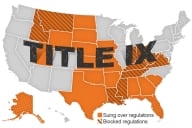You have /5 articles left.
Sign up for a free account or log in.
Yesterday, in discussing The Girl’s first batch of college applications, I mentioned the seemingly bizarre requirement that she self-report every class she has taken in high school, along with her grades, even though she also has to submit a transcript that contains the exact same information. It struck her, and me, as busywork. But since I have the best readers ever, I thought it might be helpful to ask them to shed some light.
My wise and worldly readers came through again.
Yes, there were several understandably cynical variations on “the same thing happens to job applicants with HR systems that make them retype what’s on their attached résumé.” That’s true, as far as it goes. But it also raises the question, why does either exist?
The answers that made the most sense to me boiled down to two: data analysis and speed.
The data analysis point -- raised by several readers -- was based on the fact that high school transcripts are often quite different from each other. There isn’t a standard reporting format. While that doesn’t mean much if you’re only looking at one applicant, it matters if you’re the IR office of a college trying to disaggregate data about applicants. At least for now, there probably isn’t a reliable AI device for interpreting high school transcripts from across the country automatically. The Common App can set up a standardized reporting format, though. It’s a way of outsourcing the work of coding the data to the applicants themselves. That’s a pain for the applicants, but a massive savings for the institutions.
The speed point is related. Official transcripts can take some time to arrive, but an admissions office can get to work right away on self-reported data. As one correspondent put it, they only need the official documents for students they’re going to admit; for the ones they’ll reject, it really doesn’t matter. So they start pruning the applicants using self-reported data, which tend to be highly reliable, and they verify against official documents only later, and only for the ones they intend to admit. (Presumably, lies discovered during the verification step would be grounds to rescind acceptance.)
That makes a certain institutional sense, though it’s still a pain for the applicant.
This is all quite different from community college admissions, of course. Here, applicants are not ranked against each other. If you meet the basic criteria, you’re in. That saves a great deal of time and anxiety.
(To address the question I know someone will ask: TG is not applying to community college because she does not want to. She is not an extension of me. She is her own person with her own life goals and priorities. Plus, she wants to get some distance on us. Her brother was the same way, as was I at that age.)
One of the applications she sent had a drop-down box for “gender identity,” in which the options were “yes” and “no.” It hadn’t occurred to me that gender identity was a yes-or-no question, but apparently it is. Live and learn.
Finally, one reader connected some dots that I didn’t, noting that part of the issue with electronic health records is that they aren’t standardized, either. That explains a lot. As frustrating as retyping a transcript was, I can only imagine the frustration inherent in a system in which so many different health-care providers have their own idiosyncratic ways of recording and reporting.
Thanks again to the wise and worldly readers who helped me understand! Retyping the transcript is still annoying, but it seems less random, and that’s something.
Just a few more applications to go …







